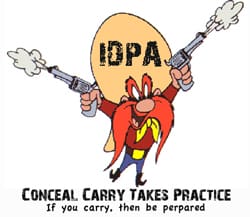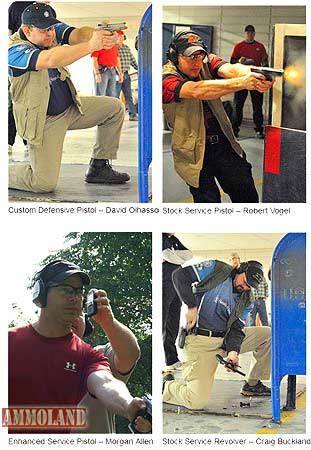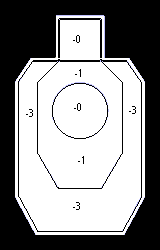Remember this series? I know, it’s been a while, but back by popular request is the continuing series of Competition Shooting 101 articles where we teach you about the various shooting sports. First we looked at 3-gun, then NRA High Power, and last time we talked about USPSA / IPSC. This time we present Bill Wilson’s personal sect of IPSC called IDPA, or International Defensive Pistol Association matches.
Originally, IPSC / USPSA (which we covered last time) was the only game in town. Sometime around 1996 IPSC started becoming more about the “game” of shooting and less about practicing real world skills, so a group of people (Bill Wilson included) split off and founded IDPA. If you haven’t read the ISPC / USPSA article yet I recommend you do before going any further, as a lot of the concepts are the same between these two sports including ready procedures — I’ll note the differences where applicable.
What is IDPA?
The general mindset of an IDPA match, and it’s raison d’etre, is summed up pretty well in the purpose statement in the rulebook.
IDPA is a shooting sport that uses practical equipment including full charge service ammunition to solve simulated “real world” self-defense scenarios.
IDPA shooting events require use of practical handguns and holsters that are truly suitable for self-defense. No “competition only” equipment is permitted in IDPA matches since the main goal is to test the skill and ability of the individual, not equipment or gamesmanship.
In short, IDPA sees itself as a way for shooters to practice their concealed carry skills in real world scenarios.
This is a great video produced by the South River Gun Club in Conyers, GA, that shows what a good IDPA stage is like. IPSC / USPSA shooters will immediately see a bit of familiarity — the start signal, moving targets, shoot / no shoot conditions and such. We’ll get into more detail later, but first let’s talk about requirements.
Click here for the full rulebook.
What kind of equipment do you need?
The good thing about IDPA is that if you already carry a concealed weapon you’re probably good to go. Just like every other competition we’ve discussed there are divisions that separate people based on the equipment they use in an attempt to keep things fair, and in IDPA the main deciding factor is the pistol you’re using.
Most of these divisions require the pistol to fit in the “IDPA Box,” which is a 8 ¾” x 6” x 1 5/8” box that sits on the registration table. If the gun doesn’t fit completely inside the box then it’s too big for those divisions. Revolvers are exempt from this rule.
- Stock Service Pistol (SSP) – Semi-automatic pistols that fit in the IDPA box with double action, double action only, or safe action triggers (no single action triggers allowed). Basically almost any Glock, SIG SAUER or S&W M&P would work. Magazine capacity is a maximum of 10 rounds (plus 1 in the chamber to start). Gun must be in factory configuration with the exception of grips, sights, and a couple other bits. Maximum weight 39 ounces unloaded (including empty mag).
- Enhanced Service Pistol (ESP) – Same rules as SSP, except the gun can be up to 43 ounces and all trigger types are allowed. So the same guns as before, but 1911s would work too. This division allows some heavy modification to the pistols, including checkering, changing of external parts, extended magazine releases, and some other stuff. SSP pistols can be used in ESP or CDP without any modifications.
- Custom Defensive Pistol (CDP) – The rules boil down to “a nice 1911.” Semi-auto, .45 ACP only, 41 ounces maximum, and has to fit in the box. Maximum 8 rounds in the magazine (plus one in the chamber to start). There are a lot of modifications allowed in this division, check the rulebook for specifics.
- Enhanced Service Revolver (ESR) – Has to be 9mm (.355″) or larger caliber making a power factor of 165,000. Maximum 6 rounds in the cylinder, barrel length 4.2,” and a maximum weight of 50 ounces unloaded. Speed loaders and moon clips are cool.
- Stock Service Revolver (SSR) – .38 caliber (.357″) or larger, ammunition MUST be rimmed and no moon clips are allowed. Ammunition must have a minimum power factor of 105,000. Other than that, with the exception of the weight (42 ounces maximum) the rules are the same as ESR.
- Back Up Gun (BUG) – This is just a “fun” division that isn’t used for serious competitions. Anything that’s 3.2″ or less barrel length for semi-auto or 3″ for revolver and is .32 cal or larger is kosher. Maximum of 5 rounds loaded at any time.
Those of you who are paying attention may have noticed that ESR indicates a minimum “power factor.” Just like IPSC / USPSA, IDPA uses the “power factor” idea. Their equation is the weight of the projectile (in grains) multiplied by the muzzle velocity. With the exception of SSR, CDP and ESR, all minimum power factors are 125,000.
As for the other equipment, whatever you can find at your local guns tore is generally acceptable. Inside the waistband (IWB) holsters are probably the best to start with due to one interesting twist compared to IPSC / USPSA:
HOLSTER, FIREARM AND SPARE MAGAZINES MUST BE CONCEALED.
From the rulebook:
All equipment should be so placed that, when wearing an open concealment garment with your arms extended at your sides and parallel to the ground, it can NOT been seen from the front, rear or sides. Your concealment garment should be practical for your environment and loose enough to allow easy movement.
Most people seem to go for the “shoot me first” vests that RF so dearly detests and are sold just about everywhere you find guns, but a large shirt or a zip-up sweater, or even a large t-shirt would fit the bill. As long as everything is invisible to the outside observer you’re good to go.
How does scoring work?
In IPSC / USPSA, scoring is generally “comstock,” but can follow other algorithms. In IDPA, scoring is done using something called the “Vickers Count” method, which converts everything to time and the fastest time wins.
The above target is a diagram of a standard IDPA target. It’s similar to the USPSA scoring zones, but the emphasis is on the “cardio-pulmonary triangle” that’s formed by your heart, lungs and diaphragm. It’s in keeping with the principle of the competition — practicing for a real world defensive pistol use.
For each stage, there is a “par” score. That’s the score that you’d have if you hit every target and never missed the head or heart. When you hit a different scoring zone, your score “drops” below that par. Miss a little and you only drop 1 point, miss a lot and you drop 3, miss the target completely and you drop 5. Add up all of those “drops” to get the difference between your score and the par score, then multiply by 1/2. That’s the time you add, in seconds, to the actual time it took you to run the course.
In addition, you can rack up penalties for doing dumb stuff that add time to your score (or get you kicked out). Penalties include:
- Procedural Error (PE) – Doing something other than what the course of fire dictated. Examples include firing out of sequence at targets, premature starts, and failing to use cover. More about that in a bit. Penalty is 3 full seconds per type of infraction.
- Hits on a Non-Threat Target (HNT) – Some targets have “hands” painted on them. These are not threats, and are equivalent to “white” targets in IPSC / USPSA. 5 seconds per target.
- Failure-to-Neutralize (FTN) – You didn’t hit a target, or didn’t hit it enough. In addition to the misses, you get another 5 seconds on your time.
- Disqualification (DQ) – You screwed up so badly that you’re a hazard to yourself and others. Put the gun away, you’re done for the day.
Things happen. Everyone I know has gotten a penalty at one point in their lives. Heck, I’m pretty sure one of my teammates has a vendetta against hostages due to the way he puts a round through every one he sees. But don’t let it discourage you, you will get better.
How do matches / stages typically work?
Go re-read the IPSC / USPSA and 3-gun posts. The commands and the procedure is almost identical, except for a couple little things.
The first difference is that YOU MUST USE COVER WHEN SHOOTING OR RELOADING. From the rulebook:
More than 50% of the shooter’s upper torso must be behind cover while engaging threat targets and/or reloading. For low cover, one knee must be on the ground and for vertical cover such as a wall/barricade, 100% of the shooter’s legs and feet must be behind cover.
The only time you should be exposed is when moving from cover to cover. Failure to use cover is a procedural penalty and adds 3 seconds to your time. You could probably game the system and never use cover, but the rulebook specifically allows disqualification for douchebags. Seriously. From the rulebook:
Competitors will not attempt to circumvent or compromise the spirit or rationale of any stage either by the use of inappropriate devices, equipment or techniques. This is the Failure To Do Right rule.
Another twist on the IPSC / USPSA style is that you can’t take a sight picture before the stage, and you can’t “rehearse” the stage. In IPSC / USPSA the competitors are generally allowed to walk around the stage before it begins and mime how they’re going to shoot it, but in IDPA that’ll get you a big fat penalty. Just like in real life you don’t get a practice run.
The final “big” change is the reloads. In IDPA, there are three kinds of reloads and the stage will generally tell you which one you’re doing.
- Tactical Reload – You’re swapping the magazine in your gun with one on your belt, but you’re going to retain the magazine in your gun for future use. Draw the new magazine first, then eject the old magazine into your hands, insert the new magazine and stow the old magazine back in a holster.
- Reload with Retention – Just like the tactical reload, except you’re not going to use the magazine in the future. Dump the mag in your pocket, pull a new one and keep going.
- Slide Lock (Emergency) Reload – The gun runs dry and locks the slide to the rear. Dump that mag like it’s hot and slap a new one in, don’t care about where the mag ends up.
Goofy reloads are fine because you’re not going to be doing may of them. No string (continuous set of targets) may involve more than 18 rounds being fired, so 3 magazines and you’re good.
Other than that the stages run the exact same way as IPSC / USPSA.
How do I find matches near me?
The IDPA website has a great list of matches organized by state that tells where the matches are, when they happen, and who to contact.
Is it worth it?
If you already carry a concealed weapon then it’s a no-brainer. For a little cash and a few rounds you get to practice a scenario using all of the gear you use on a daily basis. This is training that could possibly save your life, and isn’t a bad way to spend a day either.
Next time: Trap / Skeet!







I thought they lowered the power factor “floor” for SSR with. 38 Spl.?
Great read, thanks. I actually just looked up my “local” IDPA club. It once again reminded me how badly I have to move out of Chicago.
Aurora Sportsman Club (Waterman), Oak Park Sportsmanship Club (Plainfield) and McHenry (indoors) have local IDPA matches. Check out the IDPA Illinois Facebook page for more info.
Also, Maxon in Des Plaines run small indoor matches on Monday nights about once a month. However, those are under USPSA rules.
One thing I’d say – the biggest practical difference between IDPA and USPSA for a new shooter is round count. IDPA stages max out at 18 required shots – USPSA stages go over thirty. This can make a significant gear difference in terms of what you need to get started. Especially for revolver shooters! You can always tell a USPSA revolver shooter because he jingles when he walks.
Thanks! I knew I’d forgotten something.
Adding it right now.
IDPA didn’t update the rule book, they published the power floor change on their site as a rule change and mailed it to many MD’s. Much like the last round of rule addendums.
http://idpa.com/SSRPowerFloor.asp
SSR is a 105,000 power floor.
Noted and updated. Thanks!
I think competition is great, but I don’t see how it can be relevant to SD carry. Cops and soldiers might shoot hostage takers and run toward the enemy — but if I’m in an SD situation, I’m going backwards when I shoot and I’m trying to get the hell out of Dodge.
Shooting under some level of heightened stress. Live fire practice with reloads, draws, and movement. A better concept of what cover is.
I think all of those are pretty relevant to SD shooting. Obviously IDPA isn’t going to train you tactics, but it’s good practice for the mechanical part of self defense.
Ralph,
I totally agree. What I’ve gained (or hope to gain) from playing IDPA is composure under pressure. Are the targets shooting back, no. But there is this loud BEEP and all those eyes are on YOU, so don’t screw up.. or drop that mag, or come from behind cover, or miss that target. Ahhhh, front sight, front sight.
The game introduces a certain amount of stress and mental gymnastics that interfere with your ability to shoot and move. I think shooting in that environment is valuable.
And Fun!
Additionally, revolvers do not have to fit in the box.
Once they get off their asinine high horses about how for “safety” the range must be ABSOLUTELY cold, along with getting rid of the ability to compete with a gun that is totally impractical to carry, then I’ll think seriously about doing more competition-style shooting.
Until then, I’ll just do what I normally do at the range: Carry a loaded gun, and shoot at stuff with my buddies.
not fond of IDPA due to their” we are tactical Timmy shooters” that do not follow tactical thoughts. Just another game and will pick USPSA any day.
I much prefer IDPA to the completely irrelevant sport of USPSA. IDPA tests skills usable in a gunfight…USPSA is “track and field with a gun, usually one too big to carry”.
Thanks Nick for a useful article and explanation of the IDPA. I attended my first match today as a spectator (recovering from shoulder surgery) and this helped me pull together some of the observations made.
Comments are closed.